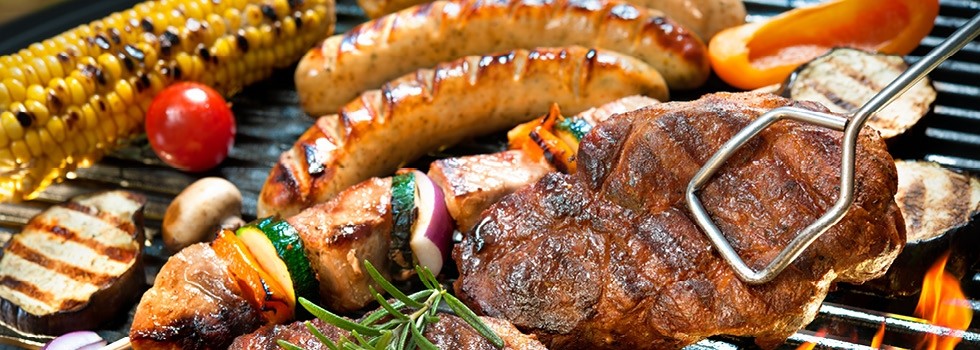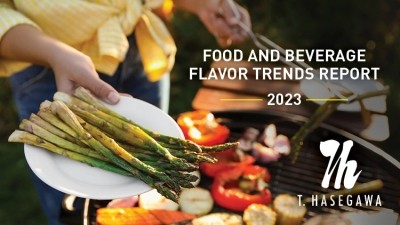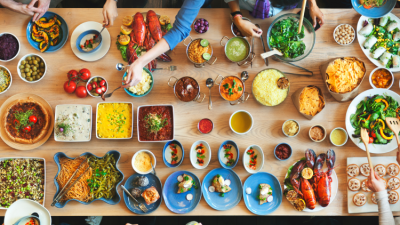Promotional Features
Savoring the Summer: How Flavor Technology is Cooking-Up Value at Barbecues, Picnics and other Outdoor Entertainment
Summer is all about long days, hot weather and active lifestyles, but it’s also prime time for barbecues, picnics and other outdoor entertainment. As temperatures rise and the aroma of scorched charcoal fills the air, people across North America gather in backyards, parks and beaches to celebrate the season with foods and beverages. Next time you’re at a barbecue or picnic this summer, look around at the diversity of offerings being served – it’s most likely a great sampling of every possible food and beverage category from salty snacks and grilled meats to sweet desserts, savory sauces and marinades, dairy and all types of beverages.
While last summer began with a degree of optimism, as people returned to restaurants more frequently after the pandemic, U.S. consumers are feeling the economic squeeze this year and changing their summer habits. With economic uncertainty and rising inflation challenging consumers across North America, the role of outdoor entertainment is growing significantly. Food and beverage brands are competing to deliver value to consumers through new product development and the flavor industry is rising to the challenge with a host of technologies aimed at dazzling the taste buds by elevating ordinary foods and beverages to offer unique experiences.
Outdoor Entertaining as an Affordable Option
Barbecues and picnics are often seen as cost-effective ways to host group gatherings and serve large numbers of people. We can expect this trend to grow throughout 2023 as the U.S. economy tightens, inflation rises and consumers shift away from foodservice options for hosting group events. According to Mintel, nearly half of all U.S. consumers feel that cooking outdoors is an affordable way to prepare a meal, and 45 percent enjoy trying new flavors when cooking outdoors.
With outdoor occasions like barbecues, picnics and chili cook-offs representing an affordable alternative to restaurants, consumers are seeking out value-add products that provide convenience and elevate the taste experience. There is a real opportunity for food and beverage brands and retailers to focus on delivering excitement – especially through products that offer compelling, intense flavors and make it easier to prepare meals.
Delivering Excitement Through Flavor Technology
The role of flavor as a source of excitement and engagement cannot be understated. Compelling new flavors are often the gateway for product trial and the main factor for repeat purchase – it’s a critical component of successful new launches. Burgeoning home chefs and seasoned ‘grill-masters’ alike are looking for the easiest, most convenient pathway to delight guests at backyard barbecues and picnics this summer, and flavor is the best way to make that happen.
Consumer demand continues to grow for authentic, true-to-nature flavors, unexpected ingredient combinations and thrilling taste experiences. The flavor industry is responding with increasingly sophisticated technology aimed at delivering intensity and even amplifying the natural flavors in food and beverage ingredients, producing great-tasting clean label products.
California-based T. Hasegawa USA, one of the world’s top flavor manufacturers, is leading the industry in developing innovative new technology that optimizes the taste of food and beverage products. Many of these advanced technologies focus not only on producing a complex flavor profile, but also delivering the ultimate taste experience, including kokumi (Japanese for “Rich Taste”), which gives foods a full-bodied rich mouthfeel.
Sweetening Summer with Flavorful Fruits
Nothing says ‘summer’ like fruit flavors. The summer months are practically synonymous with seasonal fruits like watermelon, strawberry, blueberries and peaches all featuring heavily in North American cuisine from June to September. Brands are leaning in with product development that gives consumers more of the refreshing summer fruit flavors that they crave. While traditional citrus, tropical fruits and berries are still popular across all categories, the flavor industry is broadening each of these categories to include exciting and exotic options. Traditional citrus flavors like orange, lemon and lime are being expanded with specific varietals like blood orange or yuzu, while tropical fruits like pineapple, coconut and banana are increasingly accompanied by exotic tropical flavors like passionfruit, papaya, guava and kiwi. Tropical fruits in particular are growing popular, with tropical and exotic fruits featuring in over half of total fruit launches in the last five years, according to Mintel data.
As consumers experience these fruit flavors more frequently and become familiar with these ingredients, there is a growing demand for authentic, true-to-nature taste profiles in product formulations, and the flavor industry is meeting this demand with new technologies.
Recently, T. Hasegawa introduced HASEAROMATM to the North American market. HASEAROMA is a proprietary novel technology that creates authentic sweet and savory flavors that reproduce the ‘first bite’ sensation of experiencing a food for the first time, packed with intricacy and nuances of flavor. HASEAROMA has applications across a range of flavor categories including savory, sweet, vegetable and spice, dairy, meat, poultry and seafood, it offers a distinct advantage in the development of specific, intense fruit flavors.
“The key distinction for HASEAROMA is that it offers a higher level of specificity than other compounded flavors,” said Austin Luft, senior flavor chemist at T. Hasegawa USA. “While many brands in the past may have opted for a simple mango, peach or orange flavor in product development, HASEAROMA can reproduce the specific flavor profile of an Alphonso mango or Ataulfo mango, a white peach or Golden Jubilee peach and a Clementine orange versus an American Navel orange. The expertise of our flavor chemists creating HASEAROMA allows us to refine flavors and develop products that stand out within the market and are true to nature’s essence.”
The added benefit of fruit flavors is the inherent ‘health halo’ that fresh produce offers, but statistically, consumers aren’t eating enough fruits and vegetables. According to the U.S. Center of Disease Control and Prevention (CDC), only 12.3 percent of U.S. adults met their daily recommended fruit intake in 2019, when last surveyed. Consumers are more likely to increase fruit and vegetable intake if it’s made more convenient and even fun through compelling new products that prioritize flavor and offer refreshing and authentic taste profiles.
Leveling-up Barbecue with Marinades and Sauces
It’s hard to picture a summer picnic or barbecue without sizzling meats on the grill. However, what we’re really tasting in a well-prepared beef brisket, pulled pork or roasted chicken wings isn’t just the meat itself – it’s the marinades and sauces.
Often considered a great way to easily add robust flavor profiles to proteins and other dishes, sauces and marinades draw-in consumers who are interested in exploring exciting new flavors. The sauce category also has a broad appeal with more than 94 percent of all U.S. adults enjoying these products, and rich flavor innovation is at the heart of this growing category. Sauces and marinades can elevate traditional dishes and even invigorate otherwise mundane foods with an approachable burst of rich flavor. Sauces and marinades even help deliver value through flavor without having to rely on the most expensive cuts of meat. A 2021 Mintel survey found that 64 percent of protein consumers agree that the right marinade can make any cut of meat taste good.
Sauces and marinades are perfectly positioned for flavor exploration, and consumers are generally willing to try new flavors, often with ingredients they aren’t even familiar with. Internationally-inspired marinades with rich flavor profiles such as ancho chili and furikake have led growth in menu occurrence over the last few years, according to Mintel. Consumers are increasingly exploring ingredients from around the world, such as galangal, garam masala, paprika, chipotle, hoisin, poblano chili, lemongrass and more – and incorporating these exotic flavors into traditional American barbecue fare.
“Many of these marinade ingredients have such a rich flavor profile that they’re a very cost-effective way to level-up the taste of grilled meats – a shortcut to more flavorful, restaurant-quality barbecue,” added Luft.
Refreshing with Alcoholic and Non-Alcoholic Beverages
No summer barbecue or picnic would be complete without refreshing beverages, as a way to cool off and beat the summer heat. There is a major opportunity for brands to tap into consumers’ desire for refreshment during the hottest months of the year with new beverage flavors and concepts that are uniquely tailored for summer gatherings. Often these beverage concepts are only offered for a limited time and feature seasonal fruit flavors or other ingredients that resonate with consumers during summer months.
In recent years, flavor technology has advanced in several major ways to offer great tasting solutions that deliver on consumer demands for healthier beverage options and even low/no-alcohol formulations. One of the most significant outcomes of the pandemic was a renewed interest in health and wellness, which has extended to the beverage category in the form of moderation and increased interest in low-ABV options or non-alcoholic ‘mocktails.’ Consumer interest is also high in low-calorie and reduced-sugar beverages, and even functional ingredients that offer some kind of tangible health benefit. Brands often face significant challenges creating great-tasting beverages that meet consumers’ ever-increasing BFY demands.
“When you remove an ingredient such as sugar or other sweeteners, this can sometimes compromise taste and mouthfeel, in addition to undesirable flavors in a beverage that can become more pronounced,” explained Briana Tran, beverage applications technologist at T. Hasegawa USA. “Our task is to reformulate the beverage to recover the optimal flavor profile, using technologies that either mask certain unwanted notes, or amplify desirable flavors that are already in the beverage.”
In addition to leveraging HASEAROMA for developing true-to-nature fruit flavors for beverages, T. Hasegawa also introduced BOOSTRACTTM, a proprietary Maillard Reaction-based flavor modulation technology. Boostract recovers the kokumi mouthfeel and full-bodied richness which is often lost when developing low-calorie alcoholic beverages.
“With technology like Boostract, we’re able to enhance the desirable flavors in beverages,” explained Briana Tran, beverage applications technologist at T. Hasegawa USA. “Boostract can amplify the natural flavors that are already present in the beverage and produce a much bolder taste and mouthfeel– even with a low-sugar formula.”
In lieu of excessive sugar or other sweeteners in BFY beverage formulations, brands are also exploring creative ingredient pairings, such as blending dissimilar fruits, fresh herbs, botanicals and spices in beverage applications. Summer fruits like watermelon and strawberry are being paired with mint and basil to create complex, rich flavor profiles for RTD cocktails, seltzers and other refreshing beverages. A 2022 Mintel survey even found that more than a third of participants expressed interest in trying alcoholic beverages featuring chili pepper, basil or turmeric – indicating major potential for flavor experimentation using spices and herbs.
Looking Ahead to Next Summer
No matter what the economic climate looks like, consumers will always seek out flavorful ways to enjoy their favorite foods and beverages. While there is a clear shift this year from restaurant foodservice to at-home dining and outdoor entertainment, as a response to economic challenges, there are always opportunities to offer creative flavor experiences to consumers. It’s invariably good for the industry when consumers are exploring new ingredients and demanding more from food and beverage categories, especially in the form of barbecues and outdoor gatherings that encourage sharing of creative flavors and unexpected ingredients. While none of us can predict next year’s summer trends, the flavor industry will continue to look ahead at the forces that are shaping consumer behavior and offer-up practical solutions that deliver excitement and value.
Food and beverage brands who are looking to take their product development to the next level of flavor can explore the possibilities by contacting T. Hasegawa USA at www.thasegawa.com.







